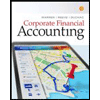
FINANCIAL AND MANAGERIAL ACCOUNTING 180
9th Edition
ISBN: 9781264216086
Author: Wild
Publisher: MCG
expand_more
expand_more
format_list_bulleted
Textbook Question
Chapter 5, Problem 5QS
Perpetual: Inventory costing with FIFO P1
A company reports the following beginning inventory and two purchases for the month of January. On January 26, the company sells 350 units. Ending inventory at January 31 totals 150 units.
| Units | Unit Cost | |
| Beginning inventory on January 1 ………………… | 320 | $3.00 |
| Purchase on January 9 …………………….……….. | 80 | 3.20 |
| Purchase on January 25 ………….………………… | 100 | 334 |
Required
Assume the perpetual inventory system is used and then determine the costs assigned to ending inventory when costs are assigned based on the FIFO method. (Round per unit costs and inventory amounts to cents.)
Expert Solution & Answer
Want to see the full answer?
Check out a sample textbook solution
Students have asked these similar questions
Help with accounting
Luke Production applies overhead using a normal costing approach based on direct labor-hours. The budgeted factory overhead was $420,000, and the budgeted direct labor-hours were 28,000. The actual factory overhead was $438,900, and the actual direct labor-hours were 29,200. How much overhead would be applied to production?
The Frontier Manufacturing had 7,200 actual direct labor hours at an actual rate of $18.75 per hour. Original production had been budgeted for 950 units, but only 900 units were actually produced. Labor standards were 9.2 hours per completed unit at a standard rate of $17.50 per hour. Compute the direct labor cost variance.
Chapter 5 Solutions
FINANCIAL AND MANAGERIAL ACCOUNTING 180
Ch. 5 - Prob. 1QSCh. 5 - Prob. 2QSCh. 5 - Prob. 3QSCh. 5 - Prob. 4QSCh. 5 - Perpetual: Inventory costing with FIFO P1 A...Ch. 5 - Prob. 6QSCh. 5 - Prob. 7QSCh. 5 - Prob. 8QSCh. 5 - Prob. 9QSCh. 5 - A Periodic: Inventory costing with weighted...
Ch. 5 - Prob. 11QSCh. 5 - Prob. 12QSCh. 5 - Perpetual: Inventory costing with weighted average...Ch. 5 - Prob. 14QSCh. 5 - Prob. 15QSCh. 5 - Prob. 16QSCh. 5 - Prob. 17QSCh. 5 - Prob. 18QSCh. 5 - Prob. 19QSCh. 5 - Prob. 20QSCh. 5 - Prob. 21QSCh. 5 - Prob. 22QSCh. 5 - Prob. 23QSCh. 5 - Prob. 24QSCh. 5 - Prob. 25QSCh. 5 - Prob. 26QSCh. 5 - Prob. 1ECh. 5 - Prob. 2ECh. 5 - Exercise 5-3 Perpetual: Inventory costing methods...Ch. 5 - Prob. 4ECh. 5 - Prob. 5ECh. 5 - Prob. 6ECh. 5 - Prob. 7ECh. 5 - Prob. 8ECh. 5 - Prob. 9ECh. 5 - Prob. 10ECh. 5 - Prob. 11ECh. 5 - Prob. 12ECh. 5 - Prob. 13ECh. 5 - Prob. 14ECh. 5 - Prob. 15ECh. 5 - Prob. 16ECh. 5 - Prob. 17ECh. 5 - Prob. 18ECh. 5 - Prob. 19ECh. 5 - Prob. 20ECh. 5 - Prob. 21ECh. 5 - Prob. 1PSACh. 5 - Prob. 2PSACh. 5 - Prob. 3PSACh. 5 - Problem 5-4AA Periodic: Alternative cost flows...Ch. 5 - Prob. 5PSACh. 5 - Prob. 6PSACh. 5 - Prob. 7PSACh. 5 - Prob. 8PSACh. 5 - Prob. 9PSACh. 5 - Prob. 10PSACh. 5 - Prob. 1PSBCh. 5 - Prob. 2PSBCh. 5 - Prob. 3PSBCh. 5 - Prob. 4PSBCh. 5 - Prob. 5PSBCh. 5 - Prob. 6PSBCh. 5 - Prob. 7PSBCh. 5 - Problem 5-8BA Periodic: Income comparisons and...Ch. 5 - Prob. 9PSBCh. 5 - Prob. 10PSBCh. 5 - Prob. 5SPCh. 5 - Prob. 1.1AACh. 5 - Prob. 1.2AACh. 5 - Prob. 1.3AACh. 5 - Prob. 1.4AACh. 5 - Prob. 2.1AACh. 5 - Prob. 2.2AACh. 5 - Prob. 2.3AACh. 5 - Prob. 3.1AACh. 5 - Prob. 3.2AACh. 5 - Prob. 3.3AACh. 5 - Describe how costs flow inventory to cost of goods...Ch. 5 - Where is the amount of merchandise inventory...Ch. 5 - Prob. 3DQCh. 5 - Prob. 4DQCh. 5 - Prob. 5DQCh. 5 - Prob. 6DQCh. 5 - What factors contribute to (or cause) inventory...Ch. 5 - Prob. 8DQCh. 5 - Prob. 1BTNCh. 5 - Prob. 2BTNCh. 5 - Prob. 3BTNCh. 5 - Prob. 5BTN
Knowledge Booster
Learn more about
Need a deep-dive on the concept behind this application? Look no further. Learn more about this topic, accounting and related others by exploring similar questions and additional content below.Similar questions
- I am searching for the accurate solution to this general accounting problem with the right approach.arrow_forwardPlease provide the solution to this general accounting question using proper accounting principles.arrow_forwardI am looking for the correct answer to this general accounting problem using valid accounting standards.arrow_forward
- Can you explain the correct methodology to solve this financial accounting problem?arrow_forwardWhy does sustainability impact measurement require special approaches? a. Standard measures capture all impacts b. Environmental factors remain irrelevant c. Traditional methods work fine d. Long-term environmental effects demand unique valuation methodsarrow_forwardPlease show me the correct approach to solving this financial accounting question with proper techniques.arrow_forward
arrow_back_ios
SEE MORE QUESTIONS
arrow_forward_ios
Recommended textbooks for you
 Corporate Financial AccountingAccountingISBN:9781305653535Author:Carl Warren, James M. Reeve, Jonathan DuchacPublisher:Cengage Learning
Corporate Financial AccountingAccountingISBN:9781305653535Author:Carl Warren, James M. Reeve, Jonathan DuchacPublisher:Cengage Learning Financial And Managerial AccountingAccountingISBN:9781337902663Author:WARREN, Carl S.Publisher:Cengage Learning,
Financial And Managerial AccountingAccountingISBN:9781337902663Author:WARREN, Carl S.Publisher:Cengage Learning, Financial Accounting: The Impact on Decision Make...AccountingISBN:9781305654174Author:Gary A. Porter, Curtis L. NortonPublisher:Cengage Learning
Financial Accounting: The Impact on Decision Make...AccountingISBN:9781305654174Author:Gary A. Porter, Curtis L. NortonPublisher:Cengage Learning Cornerstones of Financial AccountingAccountingISBN:9781337690881Author:Jay Rich, Jeff JonesPublisher:Cengage Learning
Cornerstones of Financial AccountingAccountingISBN:9781337690881Author:Jay Rich, Jeff JonesPublisher:Cengage Learning

Corporate Financial Accounting
Accounting
ISBN:9781305653535
Author:Carl Warren, James M. Reeve, Jonathan Duchac
Publisher:Cengage Learning

Financial And Managerial Accounting
Accounting
ISBN:9781337902663
Author:WARREN, Carl S.
Publisher:Cengage Learning,

Financial Accounting: The Impact on Decision Make...
Accounting
ISBN:9781305654174
Author:Gary A. Porter, Curtis L. Norton
Publisher:Cengage Learning

Cornerstones of Financial Accounting
Accounting
ISBN:9781337690881
Author:Jay Rich, Jeff Jones
Publisher:Cengage Learning
IAS 29 Financial Reporting in Hyperinflationary Economies: Summary 2021; Author: Silvia of CPDbox;https://www.youtube.com/watch?v=55luVuTYLY8;License: Standard Youtube License